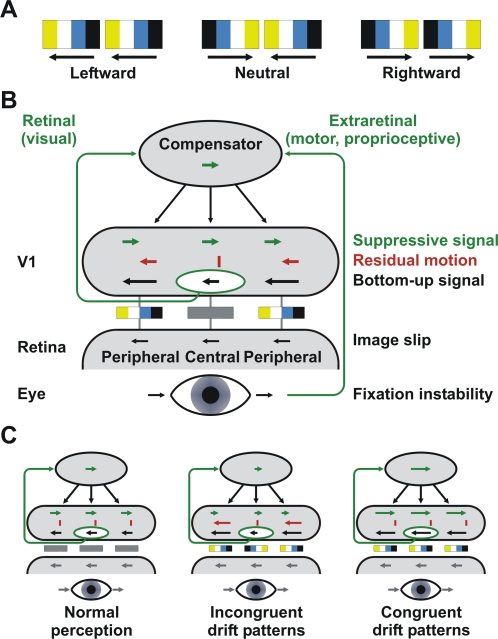Figure 1. Stimuli and hypotheses.
A) Drift patterns consisted of yellow, white, blue, and black vertical bars eliciting illusory motion in the black-blue to white-yellow direction [17]. For neutral patterns two adjacent patterns had opposite polarity. B) Hypothetical mechanisms for compensating micromovements. Small eye movements during fixation generate image slips on the retina. These image slips activate direction-selective cells in primary visual cortex (V1) (bottom-up). Perceptual stabilization is accomplished by suppressing eye movement evoked motion signals (suppressive signal) across the whole visual field. Eye movement velocities may be estimated based on extraretinal (motor commands, proprioceptive) signals or directly derived from retinal image slips as signaled in V1. Responses of direction-selective V1 neurons are biased consistent with the design rule of drift patterns [13], [17] and amplify or attenuate the sensation of retinal image slips. Residual motion signals resulting from the mismatch of bottom-up and suppressive signals are perceived as illusory motion. C) Hypotheses. In normal perception eye movements are veridically estimated leading to full compensation of retinal image slips. According to an extraretinal account of perceptual stabilization illusory motion should remain constant regardless of the arrangement of drift patterns. However, a retinal account predicts that illusory motion depends on the signals arising from the (central) visual field part that is used to estimate eye movements. Drift patterns in the central field bias the estimate of fixational eye movements. This bias will be opposite to the biased bottom-up signal of incongruent (with opposite polarity) peripheral patterns leading to strong illusory motion. Central drift patterns that are oriented in the same direction as peripheral patterns bias eye movement estimates in the same direction as the bottom-up peripheral motion signals leading to no or only weak illusory motion. For ease of understanding only rightward eye movements are shown. The same principles apply when the mean motion signals of isotropic eye movements are considered.

